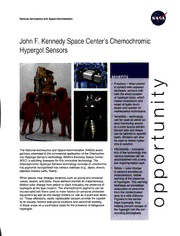
NASA Technical Reports Server (NTRS) 20130000817: John F. Kennedy Space Center's Chemochromic Hypergol Sensors PDF
Preview NASA Technical Reports Server (NTRS) 20130000817: John F. Kennedy Space Center's Chemochromic Hypergol Sensors
• National Aeronautics and Space Administration John F. Kennedy Space Center's Chemochromic Hypergol Sensors BENEFIT ~ • Precision - when placed In contact with exposed hardware, sensors lndi- I ' cate the exact location of hypergolleaks, which makes localization and • repair of leaks much c easier and quicker for maintenance technicians. • Versatility-technology can be used as efther an area monitoring sensor :::J or a point source sensor. Sensor size and shape can be tailored to specific tasks. Sensors can also . I ' be used to detect hydra- zlne In solution. \ • Affordablllty -lncorpora- The National Aeronautics and Space Administration (NASA) seeks t1on of the technology Into partners interested in the commercial application of the Chemochro 0 vartous matrices can be mic Hypergol Sensors technology. NASA's Kennedy Space Center accomplished with a very (KSC) is soliciting licensees for this innovative technology. The low Implementation cost. Chemochromic Hypergol Sensors technology consists of chemochro mic pigments incorporated into various matrices (e.g., tapes, sheets, • Saf~ - color change 0.. injection molded parts, fibers). in sensors provides an Instantaneous, visible When placed near strategic locations such as piping and container warning of the presence valves, seams, and joints, these sensors provide an instantaneous, of hypergols. This warning distinct color change from yellow to black indicating the presence of facilitates an Immediate 0.. hypergols at the leak location. The chemochromic pigments can be evacuation of personnel incorporated into fibers used to make fabrics for personal protective from the contaminated equipment as well as into badge holders for use as a point leak detec area to a safe distance. tor. These affordable, easily replaceable sensors provide the capabil Pigment In the sensor 0 ity to visually monitor leak-prone locations and personnel working traps hypergols, thus in those areas on a continuous basis for the presence of dangerous helping prevent escape of hypergols. the hypergollnto the sur- rounding atmosphere. Technology Details Hypergol detection is difficult due to the low level of detection required, the time response of the sensors, and the reactivity of the commodity. Hypergolic fuels often "stick" to the inside of sampling lines or react with water, affecting the level of detection possible with traditional sensors. Area sensors can be used to monitor wide areas but require the commodity to reach the sensor in a quantity that can be detected. Technicians often report "catching a whiff" of hydrazine while their • Power Plants handheld monitor reads zero. Trying to identify leaks with area moni • Polymers tors is a difficult task because of the complications of dilution with air movement. The high cost, slow response/recovery times, and • Fuel Cells required maintenance of area sensors make them impractical for widespread use in all areas that use hypergolic fuels. Intermittent • Metallurgy problems may also go unnoticed if there is a leak from an area that is • ExplosiVes not constantly monitored. • Pesticides KSC's improved sensor incorporates chemochromic pigments into various polymer matrices (e.g., tapes, sheets, injection molded parts, fibers), allowing the hypergol sensors to be molded into nearly any type of shape that is required. The extrusion techniques used to manufacture the sensors allow both powders and liquids to be incor porated into the polymer matrices. When applied directly to piping and container valves, seams, and joints, hypergol leaks trigger an instantaneous color change on the sensor indicating the precise location of the leak. This makes local izing and repairing leaks much quicker and easier for maintenance technicians. When located directly over a leak, the chemochromic D u.s. patent pigment used in the sensor traps the hypergol and prevents it from escaping into the surrounding atmosphere. D Copyrighted These sensors are designed to be easy to replace and to have a low 0 Available to llcenle cost of implementation. If used as a tape, the sensor can be designed to have several layers to protect it from environmental conditions or to 0 Available for no-cost transfer utilize reusable adhesive to allow repositioning of the sensor. D Seeking Industry pa11ner tor further codevelopment Partnership Opportunities All NASA licenses are individually negotiated with the prospective licensee, and each license contains terms concerning commer cialization (practical application), license duration, royalties, and periodic reporting. NASA patent licenses may be exclusive, par tially exclusive, or nonexclusive. If your company is interested in . the Chemochromic Hypergol Sensors technology, or for additional information, reference Case Number KSC-13636 and contact: Lew Parrish Innovative Partnerships Office Mail Code: ESC-22 Kennedy Space Center, FL 32899 Telephone: 321.867.5033 National Aeronautics and Space Administration Fax: 321.867.2050 John F. Kennedy Space Center Kennedy Space Center, FL 32899 Lewis. M. Parrish@ nasa.gov www.nasa.gov/centerslkennedy www.nasa.gov lechnology ksc. nasa .gov SP-2012-09-195-KSC
